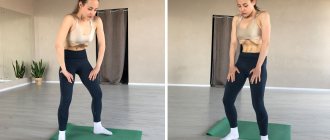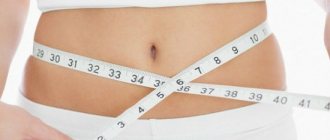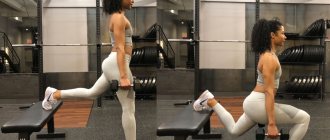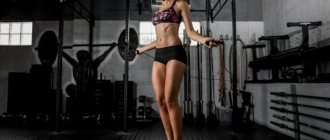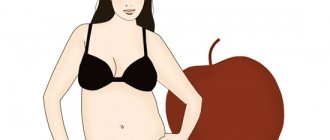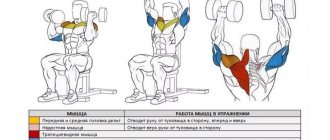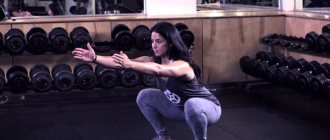Vacuum is an excellent exercise that originated in bodybuilding from yoga. It specifically works the transverse abdominal muscle, which holds the internal organs.
Vacuum is the only exercise that helps make your waist smaller . If during abdominal training your waist always grows, since muscle fiber hypertrophy occurs during training, then this exercise really helps to visually reduce your waist. You can also find information that it removes visceral fat, but this is not so, fat, be it subcutaneous or visceral, does not matter, the body accumulates any fat when there is a lack of calories, and it does not matter at all whether you work out your abs or not.
The vacuum exercise was especially popular in the 60s and 70s; it was practiced by Arnold Schwarzenegger, which provided him with a luxurious waist and large muscle volumes. Today's athletes, in pursuit of huge muscle mass, do not practice such exercises, the result is large bellies even during competitions. Moreover, the stomach “sticks out” not because the athlete has a lot of subcutaneous fat, but because the transverse muscle simply does not hold such a voluminous stomach.
How is vacuum exercise useful?
To decide whether to perform a vacuum exercise or not, we need to know how it can be useful to us.
- Vacuum will help reduce waist size. By strengthening the transverse abdominal muscle.
- You don't need any special equipment to do it. What makes the exercise universal. And it can be performed not only in the gym, but also at home, on the street or on vacation.
- Increases neuromuscular connection with the abdominal muscles.
- Frequent vacuuming strengthens the diaphragm muscles and increases lung capacity. Due to this, the chest increases slightly in volume making the pectoral muscles more expressive.
- Blood stagnation in the pelvis is reduced.
- Due to the created abdominal pressure, the oxygen content increases. This increases blood circulation.
- When performing a vacuum, a slight massage of the internal organs occurs. In particular, the intestines. Which has a beneficial effect on improving digestion.
- Strengthens the back muscles. Due to this, posture improves and pain in this area decreases.
- Vacuum calms the nervous system. Helping deal with stress. Which is not at all superfluous in the modern world.
Of course, you shouldn’t think that all changes will take place after the first execution. The vacuum exercise requires constant implementation. If you want to reduce your waist size as much as possible, you should reconsider your eating habits. Since performing only one vacuum, it is unlikely to achieve significant results.
Uddiyana bandha, or "vacuum"
Uddiyana bandha is widely practiced in hatha yoga and is used to control the flow of energy in the body. The exercise involves pressing the abdominal wall against the spine while exhaling due to a partial vacuum in the chest cavity. In this position, the internal organs rise higher than usual.
The name of the exercise speaks for itself: “uddiyana” is translated from Sanskrit as “fly”, which explains the upward movement of the abdomen, and “bandha” - “lock”, is a contraction of certain muscle groups to change the direction of energy movement in the body.
What is the difference from a bodybuilder's vacuum?
Uddiyana bandha came to us from the practice of ancient yogis, which bodybuilders subsequently began to use to form a narrow waist and define the abdominal muscles.
Arnold Schwarzenegger is a perfect example of this - he played a significant role in popularizing the abdominal vacuum by performing the exercise and demonstrating its effectiveness.
But Schwarzenegger didn’t just borrow the common practice of yoga: he added contraction of the abdominal muscles to it, making a fundamentally new exercise.
When performing a vacuum, athletes tense the abdominal muscles of the abdomen until they feel “burning”, and in the process of performing the uddiyana bandha technique, a false inhalation occurs, which allows them to press the stomach to the back and hold it in this state without using the abdominal muscles.
Benefit
- Strengthening intestinal motility - uddiyana acts like a visceral massage, stimulates intestinal motility and improves digestion
- Parasympathetic effect - due to the expansion of small arteries and improved blood flow. Calming effect on the nervous system helps fight stress
- Training the external intercostal muscles - the inspiratory muscles, which are necessary for mastering other breathing practices
- Improving blood supply to the abdominal organs
- Reducing the volume of the abdomen, forming a narrow waist and a beautiful silhouette - this may be necessary even for an athlete with a well-developed muscular frame and visible six-packs on the abdomen, because for various reasons, the stomach may still bulge
Contraindications
- High blood pressure
- Stomach and duodenal ulcers
- Menstruation
- Pregnancy, postpartum period
- Malignant diseases of any location
- Benign tumors of the abdominal cavity and pelvis
- Umbilical hernia
- Nephroptosis
- Diastasis
- Myoma
- Blood clots
- Period before puberty
The exercise involves internal organs, so you should consult your doctor before performing it!
Execution technique
The exercise must be performed exclusively on an empty stomach , the best time for this is the morning. Or any other time of day, 4-6 hours after eating.
- Take the starting position - sitting, standing or lying, as shown in the carousel.
- Take a deep breath and exhale sharply, emptying your lungs as much as possible, and hold your breath.
- Take a “false breath” - try to inhale without letting air in through your throat. The diaphragm should retract and the chest should expand.
- Retract your stomach as much as possible, pulling it up and towards your spine. Stay in this position for 10-15 seconds.
- Take a breath, relax.
Repeat the exercise 10-15 times, depending on how you feel - 1-2 approaches.
Remember, if you do not have the contraindications listed above, but you feel discomfort while doing the exercise, stop doing it immediately and consult a doctor. Be healthy and take care of your well-being
Contraindications
Although the vacuum exercise can be very useful, you still shouldn’t do it to the detriment of your health. Therefore, those who have at least one of the contraindications listed below should consult a doctor first. Who will advise you on whether to do this exercise or not.
- You cannot perform a vacuum during exacerbation of chronic diseases of the pelvic and abdominal area.
- And also for gastritis and stomach ulcers
- Intestinal diseases. Such as: colitis (inflammation of the mucous membrane of the colon) and dysbacteriosis (changes in intestinal microflora).
- Diseases of the pancreas (pancreatitis)
- Dysfunction of the biliary tract,
- Hiatal hernia. Which occurs with (obesity, constipation and prolonged cough)
- For ischemic diseases and heart failure
- When blood clots form (thrombosis)
- It is recommended to avoid performing a vacuum after operations on the abdominal and pelvic area for at least 6 months.
- For girls, vacuum is prohibited during menstruation and pregnancy.
If you feel pain or discomfort when performing a vacuum. It's not worth continuing. First, go for a checkup. Having a thin waist to the detriment of your health is not the best approach.
What muscles work?
Basically, dynamic exercises are designed to train the rectus and oblique abdominal muscles. They are located on the surface and form the so-called press. In turn, the vacuum exercise is designed to work the transverse abdominal muscles located along the waist.
The transverse muscles tighten the body, providing intra-abdominal pressure and postural support. With the loss of their tone, the waist increases in volume and the stomach is squeezed forward. This is especially noticeable in the presence of visceral fat surrounding the internal organs. It is quite difficult to strengthen these muscles with regular abdominal exercises, so it is important to vacuum regularly.
You can learn more about the abdominal muscles and methods of training them from the articles “BEST EXERCISES FOR THE LOWER AND UPPER PRESS“
How to do a stomach vacuum: tips for a thin waist
A vacuum is an exercise that is aimed at working the transverse abdominal muscle . The fact is that the transverse muscle is located deep inside the abdominal cavity. It is this muscle that is responsible for a thin waist. Meanwhile, it is not worked out with standard abdominal exercises.
To work this muscle, they use a vacuum exercise. Exercise also helps to tone the abdominal muscles, which makes the stomach flatter and more toned. The vacuum acts as a tightening of the abdomen, which is created through breathing practice.
By the way, this exercise has been known to people for many years. For example, back in the 60s and 70s of the last century, Arnold Schwarzenegger But he was not the discoverer of the vacuum. This exercise is one of the most effective practices in Hatha Yoga.
The benefits of vacuum for the abdomen
The benefits of vacuum for the body are enormous. After the first week of use you will see results. By the way, in addition to a thin waist, after the vacuum you will feel some other pleasant changes in your body.
- The spine is strengthened.
- Lower back pain from a constant sedentary lifestyle is reduced.
- The functioning of the gastrointestinal tract improves.
- Blood supply to internal organs improves.
- There is a prevention of stagnant processes in the pelvic organs.
- Creates a calming effect.
Vacuum options and techniques
The exercise itself is a vacuum, one of the lungs. Mastering his technique will not be a big problem even for a novice athlete. But you still have to work on it. In yoga, there are only 4 main options:
- Lying down
- On all fours
- Sitting (on heels or chair)
- standing
There is no fundamental difference in execution in these options. But it is believed that it is much easier to perform while lying down than standing. All this is explained by the effect of gravity on the internal organs and abdominal walls. Therefore, it will be easier to retract it. Therefore, it is best for beginners to start in a lying position and gradually strive for the standing option. For more professional athletes, posture will not play a big role when performing. Therefore, you should build on your own feelings.
Vacuum lying on your back
To make this option more comfortable, place a special fitness mat under your back. You should not do a vacuum while lying in bed. Since this surface is very soft, your back will sink.
Performance:
- We lie down on the mat.
- Press your lower back firmly to the floor.
- Bring your shoulder blades together and straighten your shoulders. We push our chest forward a little.
- We bend our legs at the knees and rest our feet on the floor.
- The arms are straightened along the body. For convenience, you can rest your palms on your hips.
- We take a deep breath and, together with the exhalation, draw in the stomach as much as possible. At the same time, try to tense the transverse muscle.
- Stay in this position for 10 seconds. Next, take a breath and relax your muscles at the same time.
- Before the next repetition, catch your breath.
- Repeat the exercise.
Don't rush to do the next rep if you feel oxygen deprived. You should not just pull in your stomach, but try to lift your navel up under your ribs. While performing the exercise, do not round your back. As for the number of repetitions, 4-5 will be enough to start with. Then you can increase it to 10.
Vacuum on all fours
This option is a more complex version of the vacuum. If before this gravity helped us and it was easier to pull in the stomach. Now, on the contrary, it acts as additional resistance. And it becomes harder to pull in your stomach.
Performance:
- Let's kneel down.
- Leans forward and rests his straight arms on the floor. In this case, the elbow and shoulder should be on the same line.
- The back is completely straight.
- The gaze is directed downwards.
- The chest is pushed forward a little (as if we are trying to breathe in)
- Exhale and draw in your stomach as much as possible. The principle is the same, we try to get our navel under the ribs.
- We stay in this pose for 10 seconds.
- And we repeat this action a specified number of times.
The technique is absolutely identical to the previous version. If it hurts to stand on your knees, then put something soft under them. It would be a good idea to stretch the muscles and joints of the shoulder girdle. Since in this position, they are used to the maximum.
Vacuum sitting
Performing a vacuum from a sitting position is much more difficult. Now the muscles that straighten the spine are involved in the work. Which keep the torso in an even position. When performing a vacuum, you can sit on the floor or on a chair. Here you can decide for yourself how it will be more convenient for you.
Narrow waist and sport
One of the main criteria for assessing an athlete’s figure in bodybuilding is its proportionality. The narrow waist allows men to achieve the desired V-shaped silhouette. The contrast of the toned abdominal area with the wide chest and shoulders makes the figure especially aesthetic. A perfect example of this is Arnold Schwarzenegger, who largely had a hand in popularizing the abdominal vacuum among bodybuilders.
Arnold Schwarzenegger.
As for women, I think that it makes no sense to explain the attractiveness of the hourglass silhouette and wasp waist. This is already obvious.
However, many athletes and just people involved in fitness are faced with the following problem: the abdominal muscles are well pumped up, often they even have six-pack abs, but the belly is still large. It is strong, elastic, but voluminous. As a result, the figure is, as they say, rectangular, and it can be even worse - the front wall of the abdomen bulges. Maybe they were just over pumped?
Let's then pay attention to naturally slender people who do not play sports. You may have noticed that often even thin girls sometimes have a protruding tummy and retracting it does not give noticeable results. Where does the belly come from if there is no excess fat and bulky muscles?
And the answer is quite simple. It's all about muscle weakness, which reduces the volume of the abdominal cavity.

